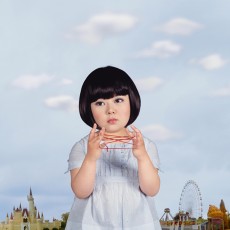 Yu Xiao’s photographs elicit a double take – not only for their densely layered paradoxical backgrounds and the strong sense of the surreal that these effect.
Yu Xiao’s photographs elicit a double take – not only for their densely layered paradoxical backgrounds and the strong sense of the surreal that these effect.
Look again at Xiao’s subject: the lone, immaculately retro-clad little girl featured in each photo. That is no child’s face that stares out from the foreground, lost in dreamlike reverie or halted in trepidation.
Not the first photographer to turn the lens inward, the resulting somewhat-latent dissonance achieved is none-the-less intriguing – as much for the method behind Xiao’s portrayal of past ‘selves’ as for the political climate within which hers were forged.
Inserting grown-up likenesses atop girl figures, it is inarguably Xiao who inhabits the jumbled memory-landscapes of her photos – vistas symbolically charged with the ‘Eighties boom and accompanying One-Child Policy of her youth in China.
 Frozen in time and unable to fledge is how these ‘selves’ have appeared in past. Viewed holistically however, each newest series is testimony to the artist’s evolution. The idiosyncratic photographer is moving toward a surprisingly universal goal: to function fully inside of oneself, just as we find that self to be, at all stages in our quest for identity.
Frozen in time and unable to fledge is how these ‘selves’ have appeared in past. Viewed holistically however, each newest series is testimony to the artist’s evolution. The idiosyncratic photographer is moving toward a surprisingly universal goal: to function fully inside of oneself, just as we find that self to be, at all stages in our quest for identity.
Did you know you would be an artist when you were a child?
No, I did not know. I knew I liked painting. I entered the CAFA primarily because I had to support myself one day – maybe as commercial photographer. However, during my studies lots of famous artists came to lecture or exhibit. This made me really excited and gradually I realize that art is part of my life. So, I dedicate myself to art and I imaged to be a famous artist some day.
So, college was formative. Who or what else?
I was an active and brisk girl who could not stay still for two minutes. But, in Chinese traditional view, girls should be gentle and quiet. My parents tried to send me to do something that could let me to be quiet. Finally, they find that when I painted I performed to be what they like. They continued to cultivate me, letting painting to be my good point.
Who or what is a strong influence upon your aesthetic/content?
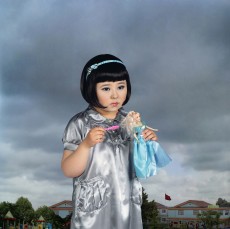 The feeling of loneliness I felt during my growing up being an only child, and the sense of loss when finding the gap between the ideal and the reality influenced my work. Such as I would like to describe an empty and silent scene, or nervous and upset atmosphere. All of these are from my growing up experience.
The feeling of loneliness I felt during my growing up being an only child, and the sense of loss when finding the gap between the ideal and the reality influenced my work. Such as I would like to describe an empty and silent scene, or nervous and upset atmosphere. All of these are from my growing up experience.
Mr. Henri Julien Félix Rousseau influenced me a lot for a long time. Staring at his works, I felt familiar. I also try to talk with him through my works.
My professors also influenced me a lot, as did my supervisor during the master’s degree, Wang Chuan, who is also a professional artist. He was always asking me lots of questions. Those questions lead me to develop my ideas, arranging and updating my creative thinking of my works. From then on, I started to think as an artist.
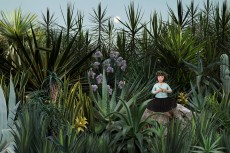 Discuss the process behind your digital montages.
Discuss the process behind your digital montages.
First I make sketches of what I want to create. Then I photograph all their elements separately. This part of the work is fun and sometimes a challenge. This also makes me happy and content. Then I bring them into Photoshop and try to piece them together. When it comes to shooting figures, it is the most complicated work. I have to work on it in the software back and forth.
How is the element of styling incorporated – do you use a stylist?
 I am my own stylist. I look at photography taken while I was a kid. I really enjoy the photo taking the most, though.
I am my own stylist. I look at photography taken while I was a kid. I really enjoy the photo taking the most, though.
How is it to study art in China?
Most professional Chinese artists access the arts through college education, but art is still not well accepted or appreciated. Not all the students graduating from the art college can be artists – most of them work as craftsmen to support themselves. But this is changing, because more and more highly educated people are starting to focus on the intellectual life, even if they are doing work with no relationship with arts. And Chinese traditional landscape painting and handwriting are more popular and accepted by ordinary Chinese people.
You place yourself as a child within your photography rather than shooting children. What are you addressing through this highly subjective structure?
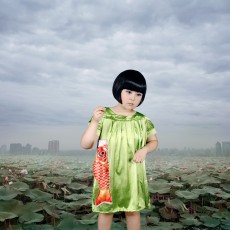 Making work about me can express my ideas the best. I have experience other people do not have, so I photograph myself. Yes, it is highly subjective. For example, Never Grow Up is the story about my growth. Born in the economic prosperity of the 1980’s, my lovely childhood was set in the glow of parents’ love and teachers’ care – such a sweet memory it is! Time goes quickly and I changed to be an adult after a glance. I found the world of adult is not a wonderful as I imagined. The first time I left the love and protection, I am so scared of the stress from the society and I cried deep down from my heart, “ I don’ t want to grow up!” Then I started to create a fantasy world through this artwork. Fantasy frozen in the spring fields, the silent village, and the path I went to primary school. In Never Grow Up, the buddies of my childhood, dolls, teddy and my little red bike appear in the frame, but they are such far away from me now. My face looks so sad, with no smile. History is always past, what I can only do is to memorize. With my wish, my artwork may bring you back your lovely memories, or sweet smile.
Making work about me can express my ideas the best. I have experience other people do not have, so I photograph myself. Yes, it is highly subjective. For example, Never Grow Up is the story about my growth. Born in the economic prosperity of the 1980’s, my lovely childhood was set in the glow of parents’ love and teachers’ care – such a sweet memory it is! Time goes quickly and I changed to be an adult after a glance. I found the world of adult is not a wonderful as I imagined. The first time I left the love and protection, I am so scared of the stress from the society and I cried deep down from my heart, “ I don’ t want to grow up!” Then I started to create a fantasy world through this artwork. Fantasy frozen in the spring fields, the silent village, and the path I went to primary school. In Never Grow Up, the buddies of my childhood, dolls, teddy and my little red bike appear in the frame, but they are such far away from me now. My face looks so sad, with no smile. History is always past, what I can only do is to memorize. With my wish, my artwork may bring you back your lovely memories, or sweet smile.
What is your interpretation of the impact of China’s One-Child Policy as it relates to your work?
The One child Policy brings the problems like this, children emotionally and financially depending on their parents. There is no doubt that only children feel more lonely and helpless when their parents are not near. However, those problems also happen in multiple-child families, because of Chinese traditional culture that promulgates that families have such very close contact during the whole life! I think these problems also depend on the family’s education and home atmosphere.
How did this play out in your own life?
It is the background of my work. The only-child policy makes me experience my life in a certain way that other people do not. However, I also feel happy that nobody would share the love with me from my parents and also the material supply.
Is the unwillingness or inability to ‘grow up’ a universal phenomenon?
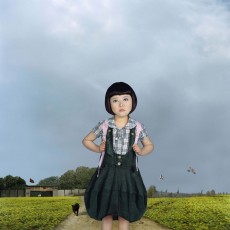 Yes, it is. People are attracted to childhood also because children have lovable appearance but mostly because they have simple and pure hearts without trouble and sorrow. This might be a reflection of people’s desire for an ideal and simple world. When youth grow up but still do not have a mature mind and heart, they have to face the gap between the ideal and the reality – and feel the loss. Also, more responsibilities make people feel nervous. With age and with more experience comes more desire and also more loss and more trouble. To never grow up is an ideal escape.
Yes, it is. People are attracted to childhood also because children have lovable appearance but mostly because they have simple and pure hearts without trouble and sorrow. This might be a reflection of people’s desire for an ideal and simple world. When youth grow up but still do not have a mature mind and heart, they have to face the gap between the ideal and the reality – and feel the loss. Also, more responsibilities make people feel nervous. With age and with more experience comes more desire and also more loss and more trouble. To never grow up is an ideal escape.
Also, adults are always fancying the young should be cute, obedient, submissive and protected. In this way, they not only output love, kindness and generosity in a condescending way, but control children; protecting the power-operation of the adult world.
In my work, I deliberately create a pitiful self-image and express “tenderized” fantasy in an exaggerated way, hoping to win viewer’s affection and appreciation – it’s sincere but also feigned. It is a time-tested trick, adopted by the (mentally mature) still young as a response against the adult world.
Could you discuss this fear of reality as it relates to your work and your personal evolution?
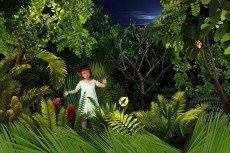 For example, the protection of young adults’ from the adult world is limited to college / graduate school. During this time, anxiety, fear and vexation towards the unknown outside is sweeping unexpectedly with suppression, rebellion and disturbance of puberty. Created under this condition, The Origin series is important transitional work for me. The self-content, agreeable tender image of the Yet Young series is now placed in a jungle in Origin. In this jungle, every plant is growing without restraint. It is a growing jungle, and a dangerous and mysterious jungle of desire. Competition, jealousy and conspiracy are interwoven. Danger is always hiding in the dark behind the brightness. Origin implies my vision of our real-life situation: an angelic child in a jungle – she has to face it by herself. Compared to the Yet Young series, the size of the figure is reduced, because I am less confident at this stage, and have stopped whining for pity from adults. I start to face this turbulent and unpredictable jungle. From Yet Young to Origin, the outside power has been emphasized, while “ego” turns into some kind of uncertainty.So, contrary to the notion that we should not mistake the art for the
For example, the protection of young adults’ from the adult world is limited to college / graduate school. During this time, anxiety, fear and vexation towards the unknown outside is sweeping unexpectedly with suppression, rebellion and disturbance of puberty. Created under this condition, The Origin series is important transitional work for me. The self-content, agreeable tender image of the Yet Young series is now placed in a jungle in Origin. In this jungle, every plant is growing without restraint. It is a growing jungle, and a dangerous and mysterious jungle of desire. Competition, jealousy and conspiracy are interwoven. Danger is always hiding in the dark behind the brightness. Origin implies my vision of our real-life situation: an angelic child in a jungle – she has to face it by herself. Compared to the Yet Young series, the size of the figure is reduced, because I am less confident at this stage, and have stopped whining for pity from adults. I start to face this turbulent and unpredictable jungle. From Yet Young to Origin, the outside power has been emphasized, while “ego” turns into some kind of uncertainty.So, contrary to the notion that we should not mistake the art for the 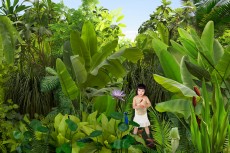 artist, the viewer of your work can in fact map your personal evolution through your progressive series’.
artist, the viewer of your work can in fact map your personal evolution through your progressive series’.
Yes, my works are all relative to each other. The first series tells my story and my experience. My work has always taken the image of the child as its’ theme, thus, my creation and thoughts are continuous and integrated. Yet Young series is my earlier works. The picture of this series focuses on me a lot. Being transited from school to society, I set my own image as a child who does not want to grow up and created a narcissistic and childlike or tenderized young image that enjoys comfortable life and refuses to grow up.
In the second series, I express the similar feeling with a different way. The plants and scenery play an important role here.
In my third series The Rhyme, I reflect my feeling and thinking using lots of children, but not me.
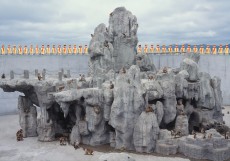 Can you talk more about that series? How have you and your themes evolved again in your current work? And do you ever see yourself ever departing from the child theme?
Can you talk more about that series? How have you and your themes evolved again in your current work? And do you ever see yourself ever departing from the child theme?
My new works are about children as well. But, The Rhyme series is significant for me because I broke my dependence of Henri Rousseau in visional pattern. I also seem to be rid of the attachment of tenderized ego and anxiety of growing, and I turned to an image-language with social criticism. The Rhyme series is inspired by my observation of an elementary school I often pass by: I see the queues all in order, hear the teacher’s criticism from the loudspeaker – exactly my memory of middle school many years ago. I started to focus on the child-image in New China. The Rhyme series are highly symbolic. The names and images are based on familiar Chinese nursery rhymes. Those signifiers are placed together in certain visual structure. Maybe explanation of each person differs, but the inner-core of those signifiers is relatively constant, because those signifiers are not obscure but come from daily life. Therefore, I am starting to try to be more of an observer and thinker with mature art-think. In my coming works, I would try to express my art-opinions with different points of view and treatment-method of my style.
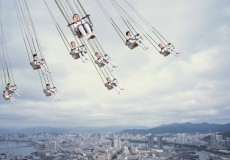 Europe and the United States are the places my work is well received. I think my work has qualities that that they are interested in the most. Beautiful and lovely picture using many processing techniques, but reflecting my true heart. I put myself in to the work, with a baby-like face and body, and people can feel for that girl with a youth’s heart. This strengthens the emotion, and makes the works compelling. Viewers may have different life experiences than me, but I think they can read my story and understand me, and then they start to think of themselves.
Europe and the United States are the places my work is well received. I think my work has qualities that that they are interested in the most. Beautiful and lovely picture using many processing techniques, but reflecting my true heart. I put myself in to the work, with a baby-like face and body, and people can feel for that girl with a youth’s heart. This strengthens the emotion, and makes the works compelling. Viewers may have different life experiences than me, but I think they can read my story and understand me, and then they start to think of themselves.
-Larissa Zaharuk
For more on Yu Xiao, here: www.yuxiao.org












